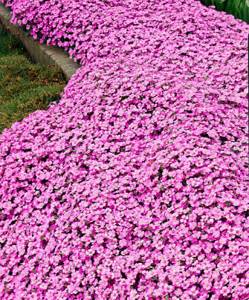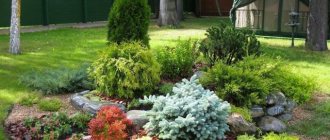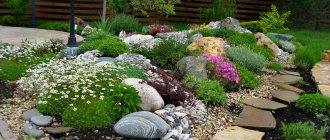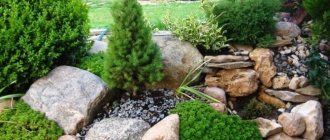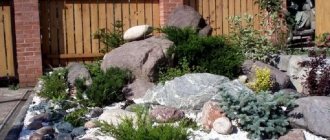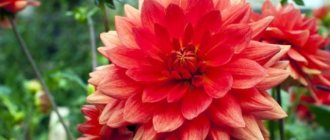- August 28, 2018
- Decoration of flower beds and garden
- Kristina Degtyareva
Often gardeners use a variety of ground cover plants to decorate their garden. The popularity of these flowers is quite simple to explain - there is hardly anything that can compare with lush flower beds or lawns on which bright, large flowers bloom. In addition, such plants do not require special care. It is enough just to plant them in the right place, water and feed them on time. Today we propose to talk about ground cover plants, their care and cultivation features. Photos and descriptions are waiting for you below!
Ground cover perennials
Variegated leaves, bright large flowers - this is what creeping plants are like. They are simply perfect for decorating ridges, flower beds and borders. In addition, gardeners often decorate rocky gardens and even tree trunks with the help of ground cover perennials. The most common flowers are those that bloom throughout the summer. However, the decorative function is not the main feature of these plants. There are many advantages, let's talk about them right now!
Pros of ground cover plants
First of all, it should be noted that such plants do not allow the wind to blow away the fertile layer of soil. In addition, they protect the soil from being washed away by rain. Another significant plus: brightly colored carpets are great for controlling weeds. The thing is that they grow abundantly, displacing weeds from the area. It is also important that ground cover flowers grow quite quickly, which means that in a short time they will create an incredibly lush carpet that can hide any imperfections in the area. Gardeners note that low-growing plants are able to enrich the soil with oxygen, thereby increasing its fertility.
Subtleties of choosing plants
Be guided by both your own preferences and climatic requirements. Low-growing and slow-growing perennials are considered the best option. This also applies to shrubs and trees.
Why are tall crops completely unsuitable for rock gardens? The fact is that they create additional shadow and prevent other species from growing. But ground cover plants for an alpine hill will be a good choice. They cover the surface, creating a general background. Just try not to plant too many ground cover plants. This will spoil the overall impression of the flower arrangement.
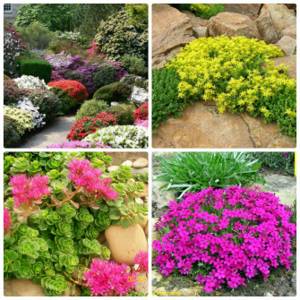
The best solution is perennial flowers for alpine hills. Plants should be planted taking into account their flowering period. This will keep the rock garden looking attractive from early spring to late autumn. The top can be planted with early flowering annuals. Coniferous shrubs will give the composition a fresh look in winter.
The artificial mountain landscape also has practical benefits. Next to ornamental plants you can plant medicinal ones - for example, sage, chamomile and thyme.
Remember these simple rules to correctly select plants for your alpine slide and protect them from death.
sedum
Experienced gardeners call this low-growing perennial a real find for a garden or rock garden. The fact is that sedum, as sedum is also called, boasts lush creeping carpets, abundant flowering and a variety of varieties. Thus, the Evers sedum is covered with delightful pink inflorescences at the very beginning of July, the thick-leaved sedum blooms snow-white flowers already at the end of spring, and the height of the dense thickets usually does not exceed two centimeters. There are other varieties:
- caustic sedum, which is usually about 8 cm in height, delights gardeners with small leaves, green and pink “stars” that bloom in late spring;
- spatulate-leaved sedum allows you to create a carpet 7 centimeters high, looking truly magical - neat rose leaves, yellow flowers of saturated light;
- rock sedum boasts that crimson flowers bloom on it in early September; this ground cover plant is characterized by flat leaves with a bluish coating and neat descending shoots;
- mountain sedum blooms throughout the summer, it has small oblong leaves and rich yellow inflorescences;
- The hybrid false sedum is very interesting; its leaves are painted in a variety of shades of green, and the buds can be pink, red and white.
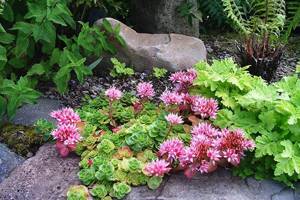
LiveInternetLiveInternet
Due to my osteochondrosis, I am increasingly thinking about creating a permanent perennial flower garden of low-growing flowers that bloom all summer. Therefore, together with you, I will try to understand their diversity.
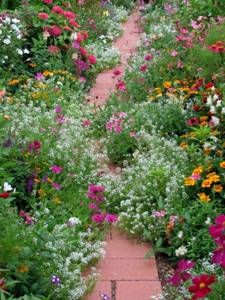
So. Article one.
Ground cover plants are creeping, low-growing flowers, usually perennial. These plants are usually unpretentious and very hardy - thanks to these qualities, gardeners use ground covers to fill empty spaces in the garden where nothing but weeds grows. And groundcovers are able to grow even on depleted soils, crowding out weeds, thereby making gardening easier.
Quite often, low-growing flowers are used as an alternative to the lawn, sowing quite large areas with them. Unfortunately, it will not be possible to walk on such “lawns” - but pedestrian paths can be laid along them. But these continuous flowering lawns require almost no maintenance. Low-growing border and carpet flowers can be selected from a selection of annuals, biennials and perennials. The most common border and carpet perennials include: a rmeria,
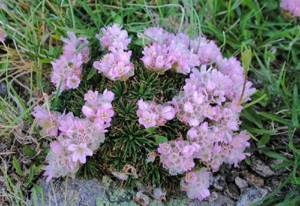
gentian,
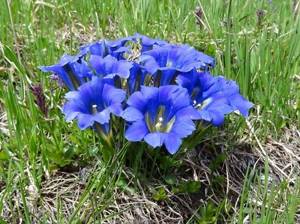
ayuga (tenacious),
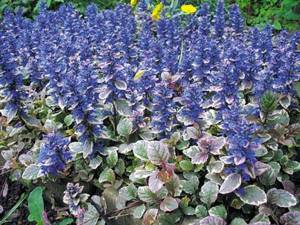
Carpathian bell,
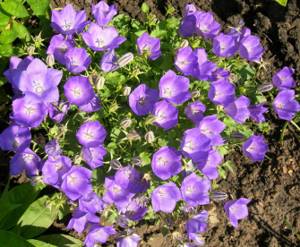
various sedums ,
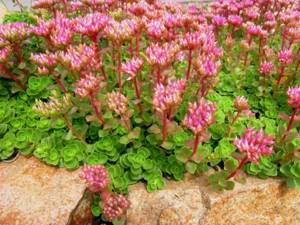
Juvenile (Sempervivum) has an attractive rosette of very dense leaves, reminiscent of a rosette in structure (one of the names of Juvenile is “stone rose”). There are numerous species of juveniles with different leaf colors (various shades of green, ruby red, bronze red, with brown leaf edges, etc.). The young spider web looks very unusual, the rosette of which seems to be covered with a white “cobweb”. The young blooms in June-August: thick, brightly colored peduncles crowned with inflorescences with pink or lilac-violet flowers rise spectacularly above the rosettes of leaves.
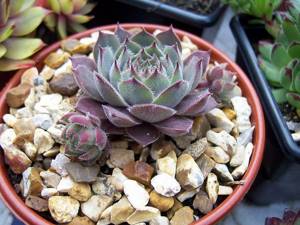
Phlox (Phlox) dwarf,
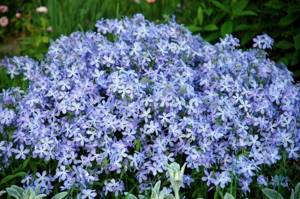
unlike their tall counterparts, they include low-growing and creeping species, as well as many of their cultural forms. They form continuous “spreads” of flowers of various colors and shades in the garden (white, pink, lavender, red, crimson, purple). - Phlox awl-shaped
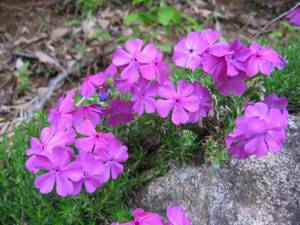
(Ph. subulata) about 10 cm high has long pointed leaves, reminiscent of the structure of needles, and is distinguished by abundant flowering in May-June. - Douglas phlox or alyssum
(Ph. douglasii) is lower and more compact than the previous species, blooms a little later.
Alyssum,
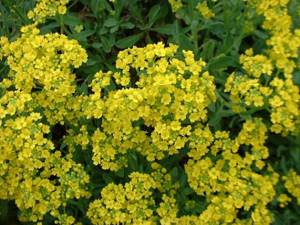
(Alissum) has grayish small leaves, blooms extremely profusely in May and early summer with lush clusters of flowers of different shades of yellow. Different types and varieties of perennial alyssum vary significantly in height. - rock alyssum (A. saxatile) is quite tall (about 35 cm), but it also has dwarf varieties (for example, “Compactum” - 15 cm, “Citrinum” - 25 cm). — mountain alyssum (A. montanum) much lower (5-10 c m)
Cerastium, or jelly
(Cerastium) produces a silvery carpet of leaves and white flowers that bloom in late spring. Widespread in gardens is the Bieberstein's sprout (C. biebersteinii), about 30 cm high. It has thin and creeping, easily rooted shoots; actively grows, covering large areas.
Gentian (Gentiana)
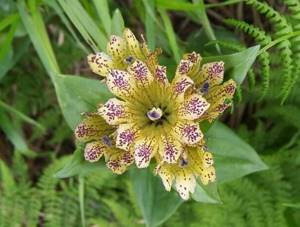
has many species of different heights, blooming in spring, summer or autumn. Of the low-growing species, the following are often grown as ground covers: - spring gentian (G. verna) 6-8 cm high with blue flowers, blooming in May. — stemless gentian (G. acaulis) about 8-10 cm high, with blue-blue flowers; flowering in May-June. - seven-part gentian (G. septemfida) about 20 cm high, blooming with bright blue flowers from mid to late summer.
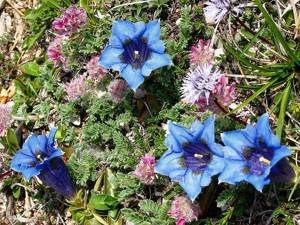
Gentian. Photo: pizzodisevo, slowly i will recover
Thyme, or thyme, or Bogorodskaya herb
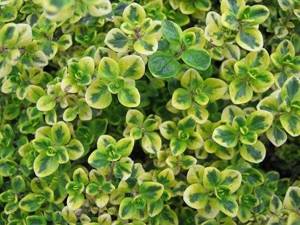
(Thymus serpyllum) is a spicy and medicinal herb with extremely aromatic leaves and flowers. The height of the thyme “mat” is 2-8 cm. Thyme blooms profusely from May to July, less actively until autumn. Many varieties and hybrids of thyme have been developed with different colors and shades of leaves (green, variegated: green-white, green-yellow) and flowers (“Pink Chintz” - pink, “Albus” - white, “Donne Valley” - light purple, "Coccineus" - red, etc.)
Veronica (Veronica) oak forest
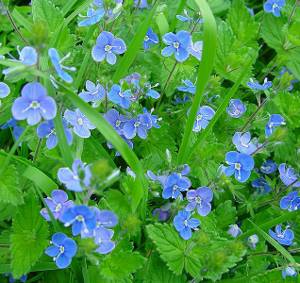
has not only tall, but also low-growing and ground cover species; among them: - threadlike or creeping speedwell (V. filiformis) grows very quickly, forming a “mat” 3-5 cm high of thin, long, creeping stems covered with light green rounded leaves. Blue flowers with dark veins appear in May-June. — Veronica prostrata (V. prostrata) is taller (10-20 cm), blooms longer (May-July) and has varieties with white, pink and light blue flowers. Saponaria or soapwort or goose soap
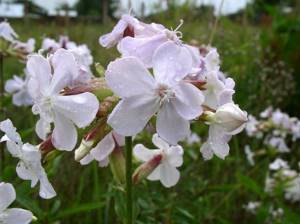
(Saponaria) forms colorful dense “cushions” in the garden with pink-red flowers: - basil-leaved soapwort (S. ocymoides) is found in gardens more often than other species; the height of its varieties ranges from 4 to 15 cm (the very elegant variety “Bressingham” is 4-5 cm tall, its flowers are pink with a white “eye”), olive soapwort (S. olivana) forms a thick “mat” about 5 cm high , blooming luxuriantly in June-July.
Periwinkle
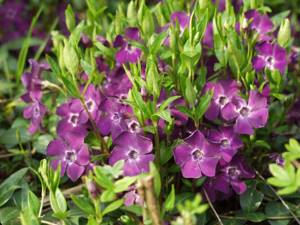
(Vinca) is an unpretentious, actively growing ground cover shrub with stems that creep along the ground and easily take root at the nodes. Periwinkle, which decorates the garden at any time of the year with its evergreen leaves, is also characterized by long flowering from May to September. Periwinkle flowers, constantly appearing among the “rug” of shiny foliage, resemble the flowers of tall phlox in their size and shape. — large periwinkle (V. major) reaches a height of about 20 cm, has blue flowers. Its variegated varieties (with white or yellow spots on the leaves) have been developed. — small periwinkle (V. minor) much lower (5-10 cm); flowers are blue or white.
Arabis or rezuha (Arabis)
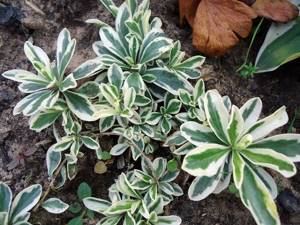
blooms profusely in May; There are varieties of it with white, pink, red flowers (simple or double) and with variegated leaves. Rezuha is great for gardens and hills; it forms an elegant cascade of flowers falling from the retaining wall.
— whitish or Caucasian rhizome
(A. albida, A. caucasica) with a height of about 20 cm is most common. Its varieties “Flore Pleno” with large white double flowers, “Pink Pearl” with pink flowers, etc. are very beautiful.
— Rezucha cilifolia

(A. blepharophylla) is less common and more compact (about 7 cm high); its variety "Spring Charm" has red flowers.
Aubrieta, or aubretia
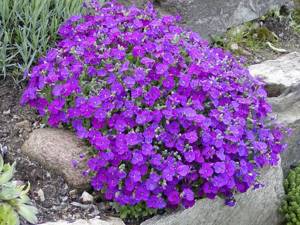
(Aubretia) blooms in May-June; it is also good as a profusely flowering cascade plant. Most often, gardeners grow deltoid aubrieta (A. deltoidea) in the garden. Its varieties and hybrids of different heights and different colors of flowers (pink, red, lilac, violet, blue), simple or double, have been bred. Very popular varieties of aubrieta are “Doctor Mules” - with purple flowers, “Red Carpet” - with red flowers, “Bressingham Pink” - with pink double flowers and others.
Sedum or sedum (see picture above)
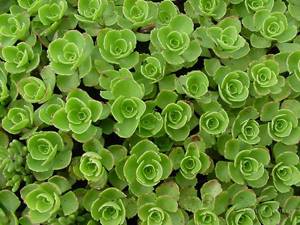
(Sedum) - just a godsend for the garden and rock garden! Completely unpretentious sedums are not afraid of heat; they grow remarkably wide on the ground and among stones. Sedums bloom profusely with small but numerous “star” flowers, collected in dense inflorescences. There are many types of sedum, varying greatly in height (from dwarfs of a few cm to tall ones (about 60 cm), with different structures and colors of fleshy leaves, with flowers of different colors. Low-growing sedums with creeping shoots form “mats”.
Source https://biofile.ru/bio/4999.html
Also worthy of mention are garden flowers:
Mesembryanthemum
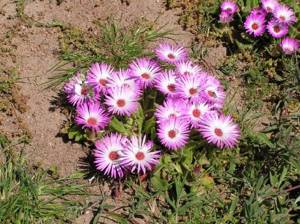
is a creeping plant with thick, fleshy leaves and equally thick stems. The mesembryanthemum grows very quickly, forming many creeping shoots. Flowers with a diameter of 4 to 5 cm come in all sorts of shades - white, pink, cream, orange, red. One plant can produce up to 20 flowers, and although some flowers open and others wither as it grows, it always looks attractive. These plants are also called sparkles, and sometimes - crystal daisy; its petals are so thin and delicate that it’s even scary to touch them: it seems that the flower is about to crumble.
ageratum,
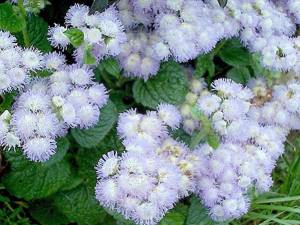
low-growing varieties of asters,

marigolds (Tagetis) rejected, i.e. short,
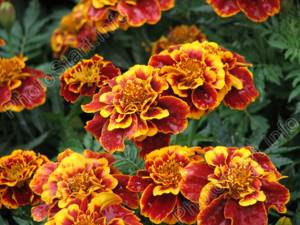
gatsaniya,
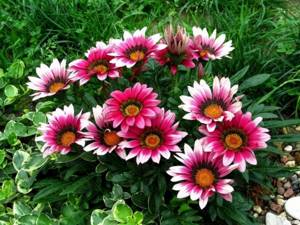
beloved pansies or violets
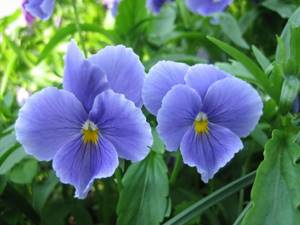
verbena,
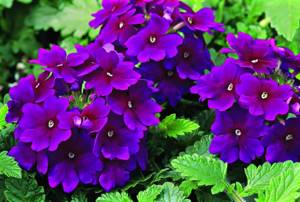
primrose,
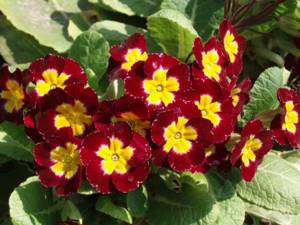
The beauty of these plants is that as they grow, they close together, creating a single, continuous shape. Plants are selected according to the principle of contrast - they must contrast with the main color of the plants, the background, and the lines of landscape elements.
What is best to plant on the sunny side?
Low perennials feel ideal here: alyssum (see description above),
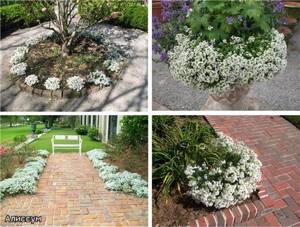
lavender,
armeria seaside
(see description above),
phlox subulate
(see description above),
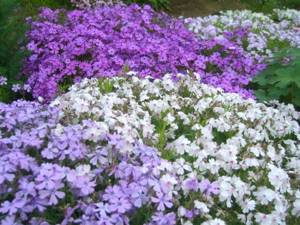
Turkish cloves,
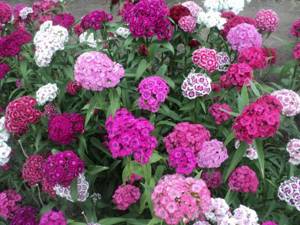
Euphorbia multiflora,
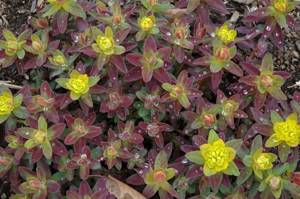
sedum (low-growing varieties) (see description above)
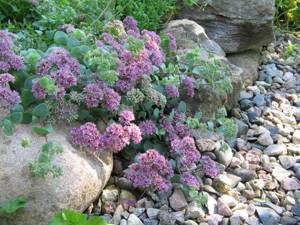
What is suitable for partial shade?
They love partial shade very much: cuff,
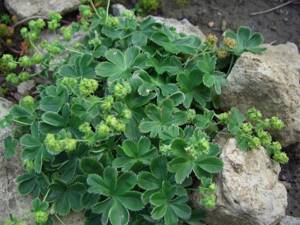
hosta,
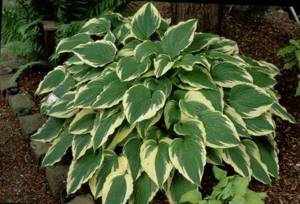
Corydalis filigree (blooms only until the end of May),
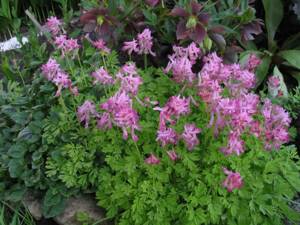
woolly brush,
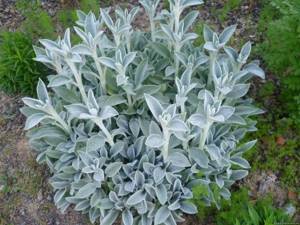
bergenia,

petunia,
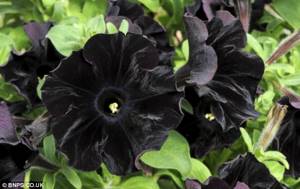
garden geranium,

sugar lungwort.
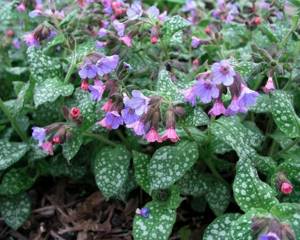
Source
https://svetok-v-podarok.ru/bordyur-sadovy-j-iz-rastenij/
I highly recommend the site about garden flowers https://5sadov.ru/decor-bed-flower-1.htm
Continuation
topics - in the material “Variegated low-growing plants for the flower garden”
https://www.liveinternet.ru/users/rudbeckia/post330884045
Series of messages “Vegetable garden”:
Part 1 - Vegetable garden on a window made of plastic bottles Part 2 - MINIATURE GARDENS IN BROKEN POTS - IDEAS FOR A GARDEN OR BALCONY GARDENING ... Part 17 - Problems of growing cucumbers Part 18 - The charm of glass Part 19 - Low-growing ground cover plants for the flower garden Part 20 - Variegated plants for flower beds Part 21 - Winter garlic ... Part 37 - Flowers that are not afraid of autumn frosts Part 38 - Cement flowerpots in the garden Part 39 - Landscape design
Series of messages “nature”:
Part 1 - MINIATURE GARDENS IN BROKEN POTS - IDEAS FOR A GARDEN OR BALCONY GARDENING Part 2 - Miniature houses and gardens. Ideas for a summer house or balcony landscaping... Part 4 - Beautiful bouquets by designer Erin Benzakein Part 5 - The most amazing beaches on Earth Part 6 - Low-growing ground cover plants for a flower garden Part 7 - Variegated plants for flower beds Part 8 - Do-it-yourself decorative panel from natural materials... Part 16 — Amber: learning to distinguish natural Part 17 — “Four Seasons” garden of the Newton couple (England) Part 18 — Tunisia. Plus two hours of dawn
Features of cultivation
Sedums of all varieties prefer fertile soils without excess moisture. They feel great on rocky areas, which is why they are so often used in the design of alpine slides. An important condition is that the plant must receive enough sunlight. With a lack of light, the stems of the sedum become elongated and lose color. This plant can survive without replanting for five years. By the way, in order for the carpet to look neat, it is necessary to trim off the flowers and twigs that protrude above the surface of the carpet. The soil should be weeded if necessary. Watering sedum is necessary only in hot weather.
What are ground cover plants?
Ground covers are low-growing, generally trailing crops that are sometimes called carpet plants. However, these two concepts are not identical, since all carpet plants are groundcovers, but not all groundcovers can be called carpets. Ground covers can reach 15-30 cm in height; they are decorative, completely cover the soil and suppress weeds.
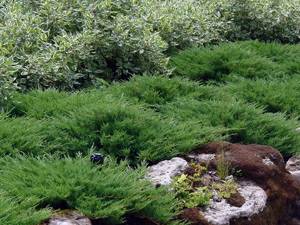
When choosing a ground cover plant, it is advisable to give preference to one that will be decorative throughout the season.
The most valuable in this regard are evergreen plants, which in areas with a warm climate do not shed their leaves even in winter.
- Hydrangea paniculata: planting, care, description of varieties
What qualities of ground cover plants make them essential in gardening? Here are a few benefits that you will surely appreciate:
- they protect the top, fertile layer of soil from being blown away by the wind or washed away by rain and meltwater;
- ground covers do not allow weeds to develop, powerfully suppressing or displacing them from the site;
- these plants quite quickly fill the area allocated for them, hiding all its shortcomings and giving it a well-groomed and picturesque appearance;
- ground covers saturate the top layer of soil with oxygen, make it more fertile, prevent the surface from overheating, and prevent the rapid evaporation of moisture and the formation of crust.
Subulate phlox
These ground cover flowers can reach a height of 16-20 centimeters, they form a rather dense and dense green carpet with surprisingly bright inflorescences of various shades: the flowers can be red and crimson, white and purple. Awl-shaped phlox usually blooms twice a year. The first time they bloom their buds is at the very end of April. Flowering continues until mid-summer. The second flowering begins in September. These ground cover plants in landscape design, according to gardeners, are universal - they can replace a lawn; phloxes look great on alpine hills, as borders along garden paths.
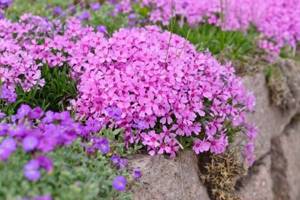
Rules for growing phlox
These delightful, fast-growing groundcovers prefer loose, mineral-rich soils. It is best to plant these flowers in sunny areas. Please note: subulate phloxes do not tolerate waterlogging, however, in case of prolonged drought, the plant must be moistened in a timely manner! Gardeners recommend mixing the fertile soil in which you are going to plant flowers with dolomite flour and sand. By the way, trimming flower stalks stimulates re-blooming.
Ladonnik
Thinking about what you can plant instead of a lawn? Pay attention to creeping flowers such as palmetto. Kotula (this is the second name of this plant) is particularly popular among gardeners for a reason: throughout the summer it pleases the eye with delicate yellow flowers that emit a delightful aroma. The neat glossy leaves of the plant contrast with the inflorescences. The most common cotula are comb, rough and cinquefoil. Their height does not exceed ten centimeters. Landscape design experts say: this plant can get lost in a flower bed; it is best to plant it on rocky areas or as a lawn.
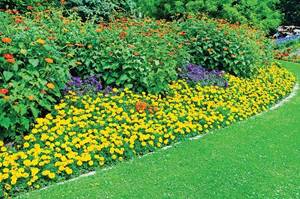
Annuals for carpet beds
The advantage of using annual flowers is the ability to give the flowerbed a new look every year. When creating a flower garden, you should take into account the flowering period, depending on which the plants are divided into:
- spring;
- summer;
- autumn.
To ensure continuous flowering, it is better to use both groups of plants.
Of the spring annual flowers that bloom in late spring, you can plant:
- Begonia. The plant is able to grow in the shade of taller flowers.
Provided there is an early and warm spring, it can be planted in the ground in May. Loading… - Petunia. You should choose hanging varieties that cover the soil. So, one bush can cover up to 1.5 square meters. m.
- Iberis. Seeds can be sown directly into the soil. Serves to decorate the edge of a flower bed, grows no more than 35 cm and blooms for 2 months, starting in May.
Summer plants begin to bloom in June. From this group the following will look good in a flower bed:
- Cornflower . Blooms all summer.
- Zinnia. Dwarf varieties grow up to 25 cm and bloom from the end of July.
- Marigold. For a round flower bed, it is better to use French marigolds, which do not grow more than 30 cm. They bloom from June to October.
Representatives of the third group bloom closer to autumn and bloom until the onset of frost:
- Snapdragon. Blooms from late summer until frost.
- Dwarf asters. Late varieties bloom at the end of August and are able to withstand frosts down to -7 degrees.
Planting and care
The palmetto prefers a large amount of sunlight, and therefore it is better to choose well-lit places for it. There are no special requirements for the composition of the soil; this plant can bloom even on poor rocky soils. The only thing a kotula needs is a sufficient amount of oxygen. Do not forget to loosen the soil in a timely manner. This plant only needs a small amount of moisture, so it can be satisfied with seasonal precipitation; it does not need additional watering, nor does it need fertilizing.
Roses
Looking for ground cover perennials that bloom all summer? Gardeners recommend paying attention to new generation roses. These flowers bloom at the very beginning of June and decorate the area until autumn. Try to take a closer look at the roses of this group: they differ in a variety of parameters - color and size, single flowers or buds collected in inflorescences, aroma. However, the main thing that distinguishes different varieties of ground cover roses is the length of the shoots. For example, there are varieties whose shoot length ranges from 35 to 70 centimeters, and there are those that spread 5 meters along the ground! Where can you plant these ground cover plants? They are unlikely to be suitable for alpine hills, but for creating bright and unusual lawns, flower borders and strengthening slopes, they are simply irreplaceable!

Benefits of ground covers
The main advantage of groundcovers is their absolute unpretentiousness. It doesn’t matter at all what climatic conditions the site is in; there are varieties that grow well in dimly lit areas with poor soil. In some cases, on well-fertilized soil, plants stop blooming and disappear into green mass.
The peculiarity of the root system of creeping plants allows them to be used as a border for a flower bed. The roots grow not deep, but wide, and intertwining, do not allow the soil to crumble.
Where can ground cover plants be used:
- like a living lawn in the vicinity of bulbous and tall plants;
- alpine slides, rocky gardens;
- to create unusual paths by planting between the slabs.
Almost all groundcovers are perennial varieties. And there is no need to purchase seed every year. Many gardeners use plant characteristics to control weeds. Growing into a carpet, they leave no chance for weeds to grow without interfering with cultivated varieties. Many groundcovers have leaves and stems that die off during the winter. Fallen greens are an excellent fertilizer and protection against freezing of the roots.
How to grow roses
Like other types of roses, groundcovers love light. Only if the plant gets enough sunlight will it bloom long and luxuriantly. However, it is important to take into account that scorching rays can lead to burns and wilting. Under no circumstances should ground cover roses be planted in the shade, for example, under trees or against walls. In this case, the root system will slow down, the plant will get sick and die. The best soil is loamy soil, but dry sandy soil is contraindicated for roses. Caring for ground cover roses is practically no different from the care required for other species. The main thing is to water and fertilize them on time.
How to get planting material
The homeland of many species is in areas with a hot, dry climate, so in the middle zone, with a lack of heat, they practically do not bear fruit or the seeds do not have time to ripen. The main method of propagation is cuttings. To obtain planting material, you must have special, so-called mother plants. From September to May they are kept indoors, with different groups needing different temperatures. Thus, alternators, coleus, heliotropes require about +12 °C, and pelargonium, gnafalium, santolin and fuchsia +5...+7 °C. To increase the number of daughter rosettes, the apical growth point of the mother plant is removed, which stimulates the awakening and growth of axillary buds.
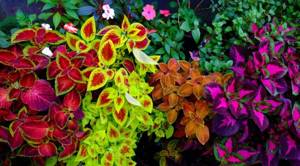
Most plants are usually taken from cuttings in February-May, and from cuttings rooted in February, shoots suitable for repeated cuttings can be obtained. Usually, during reproduction, the temperature is maintained at +18…+20 °C. Carpet plants do not tolerate transplantation well, so after rooting, the cuttings are planted in separate pots to minimize further damage to the root system. Seeds are sown indoors in March, and the plants will be ready for planting in open ground no earlier than a year later. The main thing is to maintain planting density. If for summer gardens the norms range from 25 to 60 pieces per meter, then 100 and even 200 pieces per m2 are planted in carpet flower beds. Failure to comply with this rule leads to loss of decorativeness and failed, loose areas in plantings.
Saxifrage
If your site is in the shade, you should choose shade-loving ground cover plants. These include the unpretentious beauty saxifrage. She is able to survive even in the harshest conditions: she can be found at the foot of mountains, on rocks and embankments! This plant got its name not by chance, the whole point is that saxifrage settles in the smallest cracks of stones and gradually destroys them with its roots! Saxifraga blooms in May, flowering continues throughout the summer. The flowers are usually white, but there are varieties with yellow, pink and red inflorescences.
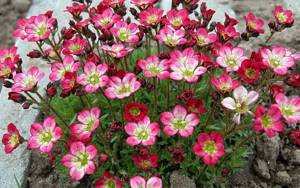
Which coniferous plants to choose for a rock garden?
Among the abundance of coniferous plants, we recommend choosing and planting the following varieties: western thuja, common and Canadian spruce (also called gray spruce), Korean fir and junipers. Keep in mind that the height of coniferous trees for an artificial flower garden, regardless of its type and shape, should not exceed 70 centimeters. You can combine them as you like, creating contrast in shape and color or making smooth transitions.
Follow these recommendations so that coniferous shrubs and trees become a worthy decoration of your corner of nature.
Herbaceous plants for the hill: name, description, photo
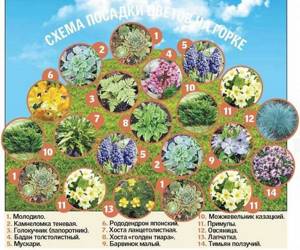
Let's find out exactly which herbaceous plants gardeners and landscape designers recommend using when it comes to an alpine hill and its arrangement.
Periwinkle
Pay attention to the photo - the plant has bright blue flowers, creating good volume along with green leaves. The plant is absolutely unpretentious in care, feels great in the sun and in shaded places. Using it, you can create a very lush, incredibly bright carpet. Typically, periwinkle begins to bloom in May and ends in September-October.

Saxifrage
Saxifraga is a perennial that can grow even in the harshest conditions. Even where there are ordinary stones instead of soil, saxifrage will feel quite comfortable. By the way, this is where the name comes from. The photo clearly demonstrates that on an alpine hill plants such as saxifrage can have a wide variety of color shades. In total, there are almost 370 species in nature.
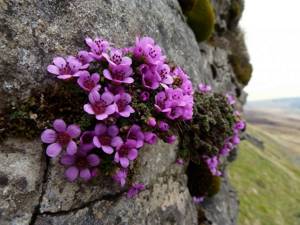
Soddy pike
Ornamental grass, the second name of which is “meadow grass”. It looks like a very dense hummock with hard leaves and spikelet inflorescences in the form of a panicle. Pike loves moisture, but an arid climate can be disastrous for it. There are various types of pike in nature, with varied colors. It begins its growth in April-May, it slows down in the summer, and is restored again in the rainy autumn.
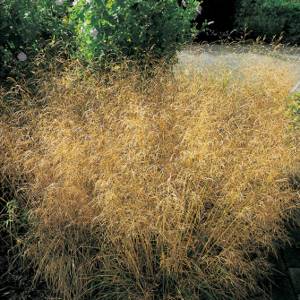
Soldanella
Spanish name, which literally translates as “small coins.” A variety of mountain flowers also called snowbells. The size is relatively small, blue and white peduncles are most often found. Soldanella loves moisture, so you definitely can’t do without moist soil and reliable drainage. However, not every flower can compare with it in attractive appearance.
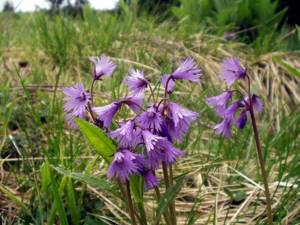
Asparagus
In general, there are about 300 varieties of asparagus. In our country it is sometimes called “asparagus”. You will immediately recognize asparagus by its thick, needle-like greenery. The inflorescences are small white flowers, bright red berries. It is best to take whorled or spherical asparagus for a rock garden, the bushes of which are more compact.
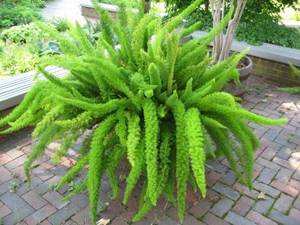
Sunshine
It is a low bush with creeping stems. The leaves are gray-pubescent, the flowers are yellow, pink and orange. Sunshine loves alkaline and sandy soil. The plant is a young plant and is propagated by cuttings. Coin sunshine is the most popular species found in landscape design.
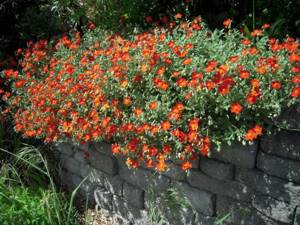
Grouse
The hazel grouse is not only a bird, but also a wonderful bulbous plant. It got its name because of its truly variegated color. In gardening, you can most often find fritillaria with bells hanging down. Among the low varieties, hazel grouse Alba and Aphrodite attract attention.
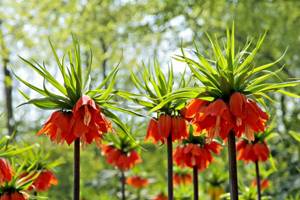
Pushkinia
We continue to tell you about plants for alpine hills with photos and names. Next up is Pushkinia. The plant is bulbous and blooms in early spring. The first flowers of the forest-like Pushkinia can be seen in March-April, while the hyacinth blooms mainly in May.

Bladderwort physalis
A perennial with leaves, the height of the bushes reaches 20 cm. The flowers are purple and are collected at the top in the form of an umbrella. The bladderwort is very unpretentious in care and loves the sun. It begins to bloom in April, after which the seeds appear. However, the main highlight of this plant is its unusually shaped leaves.

Poultry farmer
There are more than 120 species of poultry grass; bushes with small white or yellow flowers are used in landscape design. Very easy to care for, prefers sunny areas. Completely undemanding to soil.
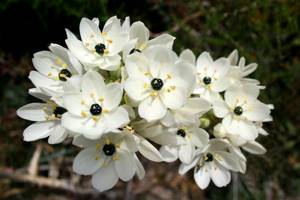
Lumbago
Whatever perennial plants you choose for alpine hills, there must be sleep grass on the site. This is what people call lumbago. This plant has straight leaves and stems that are covered with small hairs. The height of the plant is 30-40, but not more than 50 centimeters. The flowers are very large, shaped like a bell. The color scheme is quite varied: golden, violet, purple and silver shades.
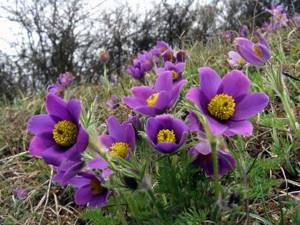
Edelweiss alpine
That same romantic plant that symbolizes love and fidelity. Despite the relatively small size (height - 15-20 cm), the yellowish inflorescences-baskets of edelweiss are visible from afar. The star-shaped leaves also look charming. Be sure to decorate your landscape with this plant!
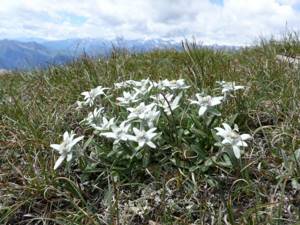
Linen
Since there are several varieties of flax, it can be annual or perennial, as well as a subshrub. 20 species are used in landscape design, mostly large-flowered flax. Thanks to its delicate shades, linen looks great against the background of gray stones. Loves sunlit places, a little shade is allowed.
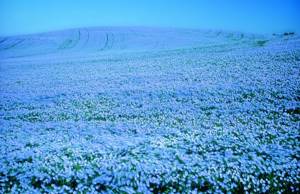
Of course, these are not all the plants that are planted on alpine hills and decorate them with their splendor. There are also cinquefoil, iberis, alyssum, and young ones. Combine different types, do not hesitate to imagine and be creative - you will definitely succeed!
Saxifraga care
This plant is very unpretentious, quickly takes root in a new place, creating a lush carpet with a height of five centimeters. Saxifraga feels great both in partial shade and in illuminated areas. As for the soil, it is better to choose drained substrates for this plant. Before planting saxifrage, the soil must be dug up with gravel, peat, slaked lime and sand. This plant, also called gap-grass, feels best in high humidity. Gardeners recommend periodically spraying or watering plants using the sprinkling method. Saxifraga quickly covers the entire surrounding soil, and therefore does not need weeding. Another positive feature is that this plant can overwinter without shelter. Even if some of the shoots froze during the cold weather, the young shoots will cover all the bald spots that have formed in the spring.
Varieties of perennial plants
To grow a flower carpet you don’t need to be a master. These plants are ideal for beginners and those who want to spruce up an empty area without spending any money.
Conventionally, all groundcovers are divided into flowering and with decorative leaves, creeping and climbing, shade-tolerant and sun-loving. It is recommended to choose them taking into account the characteristics of the site and personal preferences.
Creeping and creeping species
One of the fragrant and healthy creeping herbs is thyme. It grows even in dry places under the scorching sun, but does not tolerate acidic soils. Virtually no need for watering or fertilizers. It begins to bloom in late spring or early summer with small pink flowers. Cut shoots are used in cooking and to treat colds. Propagated by bushes and self-sowing.
Bryozoan (Irish moss) is a plant that resembles moss. It grows well in sun and partial shade, growing in evergreen cushions up to 8 cm high. It is resistant to trampling, which makes it an excellent replacement for lawn grasses. The flowering period is from the beginning of summer until the first frost .
The awl-shaped phlox looks interesting even without flowers. The small leaves of the plant look like needles. The bushes are dense and as they grow, the ground becomes covered with a thick, prickly carpet. It begins to bloom in May with pink, white and blue inflorescences. All varieties are planted in flower beds at the same time. Delicate shades combine perfectly with each other and create interesting color transitions.
Dusheniya is an attractive fruit-bearing perennial. Visually similar to strawberries, but not edible. It grows in well-lit places and does not need fertilizing. The flower is quite aggressive and it is advisable to grow it separately from other plants. It overwinters well under a layer of snow, but in severe snowless winters it can freeze out.
Shade-loving flowers
Shade-loving perennials are of great interest to gardeners and landscape designers. They are used in areas where there is rarely sun.
Chopper is an excellent option for tree trunk plantings. Loves moist soil and winters well. It blooms with not very expressive flowers. Loved by gardeners for its beautiful glossy dark green hoof-shaped leaves.
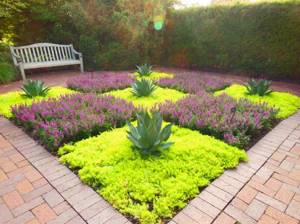
Creeping tenacious can grow anywhere, but prefers light partial shade. Prized for its beautiful leaves and ability to quickly cover large areas of ground. It grows well even on slopes and blooms with white and pink flowers.
Saxifraga grows in small bushes. Prefers places with shading, as it can fade in the sun and lose its decorative properties. It blooms from May to August with white, yellow, pink inflorescences.
Sun-loving species
Unlike shade-loving plants, sun-loving plants prefer bright light. They can be planted in shaded areas, but in this case they will not bloom.
Carnation grass is a herbaceous perennial that blooms in the first half of summer with small fragrant inflorescences. Does not bloom in the shade. It tolerates winter well and does not need shelter.
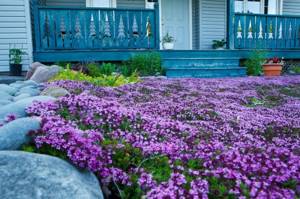
The parsley is a delicate ground cover flower with pale green pubescent leaves and white inflorescences. It grows only in well-lit areas. Does not require special watering or fertilizers. It grows quickly and blooms from the beginning of May.
Sedum is loved by many gardeners for its unpretentiousness. It practically does not need fertilizing, winters well and blooms all summer. It manages almost without watering, but in the dry season the soil under it must be moistened.
With proper care, primrose turns into a blooming carpet. Needs good hydration without stagnation of water. Does not like heavy soils, preferring acidic and slightly alkaline ones.
Yaskolka
Among the best ground cover plants with white flowers is the actively growing chickweed. This plant forms dense cushions on which the silvery color of the shoots is combined with snow-white flowers. Yaskolka is distinguished by its endurance and undemanding conditions. It is for this reason that landscape design experts recommend planting it in rock gardens and rock gardens. It should be noted that any species of this plant quickly covers large areas.
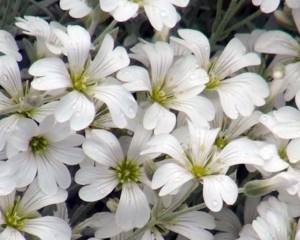
Use in design
Carpet plants used to create complex compositions: portraits, flower clocks, slogans, decorative flowerpots and even animal statues. This is technologically complex and expensive, so it is most often used in urban landscaping. When creating a large carpet flower garden, you must remember that it is designed to be viewed from afar - from the windows of the house, from the terrace. It’s easy to create small flower beds on your site - in the form of ridges along the path or flower beds in front of the porch, so that you can take in the entire pattern.
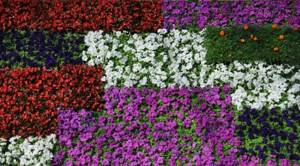
The leaf blades of pelargonium Solleri and cineraria have a silvery and gray tint. The yellow color is given by the leaves of Coleus Yulke and golden pyrethrum. To obtain red tones, coleus, achyranthes and iresine are used. Purple leaves of balsams and coleus. Plants with variegated leaves are also common: cordifolia mesembryanthemum, striped tradescantia, crested chlorophytum, zonal pelargonium. Most carpet plants are decorative due to their leaves, but there are beautifully flowering species that produce deep purple (heliotrope), red, white and pink colors (pelargonium) in flower beds.
Rules of care
Gardeners recommend choosing exclusively sunny areas for this crop. The fact is that partial shade can lead to a decrease in the splendor of flowering and slower growth. But this plant is not afraid of drought and heat, and it is not afraid of drafts, because the shoot is quite low - only 20 centimeters. The soil for it should be both nutritious and loose; it is best to choose sand-based soil, in which humus and compost must be added. Even in the conditions of the middle zone, this plant does not need additional shelter for the winter; it belongs to the category of completely winter-hardy. Caring for the seedling is quite simple: during the summer season you need to apply mineral fertilizers twice, and in the spring you should remove shoots that escape from the cushions.
Carpet plants
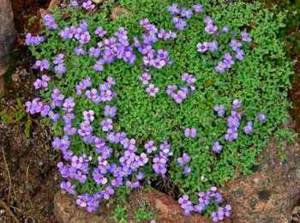
Carpet plants are flower and decorative deciduous herbaceous plants with beautifully colored foliage that are easy to trim. Most of them are perennial, so the mother plants of carpet plants are stored in a greenhouse during the winter.
In flower beds, carpet plants give the following colors:
- silvery - silver wormwood, Solleri geranium, geranium, Echeveria desmeciana, Echeveria metallica;
- gray - gnafalium woolly, santolina, sedum carneum;
- yellow - golden alternanthera, Julke coleus, golden pyrethrum, golden sedum, golden fuchsia;
- pink - alternanthera pleasant;
- red - Alternanthera Yuvel, Alternanthera amena rosea, Achyranthes, Irezine;
- purple - Alternanthera metallica, Coleus Gero;
- blue - creeping gum, blue sedum, echeveria;
- variegated - Tradescantia striped.
In addition, there are beautifully flowering carpet plants: heliotrope, geranium.
Propagation of carpet plants
Basically, all carpet plants are propagated by cuttings. Alternanteras and sedums are cut directly into the soil of the greenhouse, then, without replanting into pots, they are planted in flower beds. Cuttings begin in May. Cuttings 3-5 cm long are cut from mother plants that have overwintered in the greenhouse and planted in a greenhouse - 1000 pieces. for 1 µv. The greenhouses are covered with frames, the glass in which is sprayed with chalk solution for shading. After 3 days, the greenhouses are ventilated, after 5-6 days the cuttings take root. They are planted in open ground when the danger of frost has passed. Alternanthera are especially sensitive to cold weather (their leaves quickly turn black).
Achyranthes and gnafalium are rooted on racks with bottom heating. Cuttings of fleshy plants (mesembryanthemum, echeveria, sedum, klenia) are slightly withered before planting so that the cuts dry. They are not watered immediately after planting, as the plants quickly rot.
Cuttings of carpet plants begin in the second half of January. The cuttings are planted in sand (layer 1.5-2 cm), under which there is soil (layer 8-10 cm). Fresh sawdust (layer 8-10 cm), previously disinfected with boiling water or a weak solution of potassium permanganate, is also used. Cuttings are placed in 500 pieces on the rack. per 1 micrometer, sprayed with water and shaded with paper for 2-3 days. After rooting, carpet plants are planted in pots filled with a mixture of turf soil, humus soil and sand (2: 4: 1). Young plants are placed on a rack with sand (layer 5 cm). Further care consists of systematic watering, weeding, and pinching.
Caring for carpet cuttings
At the end of March - beginning of April, the plants are taken out into warm greenhouses, covered with frames, and insulated with straw mats at night. Every 3-4 days, the greenhouses are ventilated by raising the frames; when warm weather sets in, they are removed completely. After such hardening, the plants are ready for transplanting into open ground.
The need for mother plants is calculated based on the cultivation plan and the average yield of cuttings per bush. An average of 50-60 cuttings are obtained from mother plants of alternanthera, achyranthes, gnafalium, irezine, coleus, and santolina; from heliotrope, mesembryanthemum, sedum carneum, fuchsia - 15-20 each; from geranium, echeveria - 4-5 cuttings. For uterine purposes, well-developed young plants are left.
Carpet plants growing in the soil of the greenhouse, after being removed to the flower beds, are transplanted into pots with a diameter of 9-11 cm (3 pieces each), the rest - from pots with a diameter of 7 cm into pots with a diameter of 11-13 cm. The mother plants are left in the greenhouse, covered with frames . The first time is ventilated 3-4 days after planting, then more often, at the end of the second week the frames are removed completely. Regular care: watering, weeding, but fertilizing is not recommended.
At the beginning of September, when the air temperature drops to 10 °C, the greenhouses are closed again with frames at night. In the second half of September, mother plants are brought into a pre-disinfected greenhouse and placed on racks with sand (5 cm layer) for winter storage.
In winter, mother carpet plants are watered moderately, weeded, and the buds that appear are removed.
Soil conditions for carpet plants
Carpet plants develop well on turf soil with a small addition of manure humus and coarse sand. Care consists of periodic watering, weeding and timely trimming of plants.
All carpet plants are used to create flower beds, ridges, borders, and landscape compositions.
Surely this will also interest you:
- climbing plants
- fragrant flower
- Geranium - varieties, properties and use
- Coleus, or nettle
- Originally from Brazil
Arabis
Another fairly hardy plant: Arabis is not afraid of either drought or cold weather. The length of the lash of this perennial usually reaches 50 centimeters, the delightful emerald foliage is decorated with neat bright inflorescences, the most common shades being white, cream, pink and lilac. Flowers can be either double or simple, collected in dense inflorescences. The fragrant carpet pleases gardeners for a whole month.
